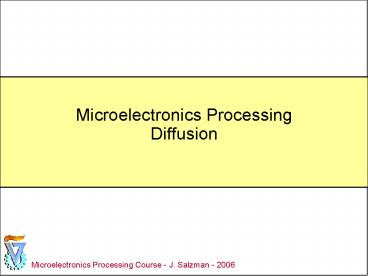AMAT PowerPoint PPT Presentation
1 / 33
Title: AMAT
1
Microelectronics Processing Diffusion
2
Doping
- Doping is the process that puts specific amounts
of dopants in the wafer surface through openings
in the surface layers. - Thermal diffusion is a chemical process that
takes place when the wafer is heated (1000 C)
and exposed to dopant vapor. In this process the
dopants move to regions of lower concentration. - Doping Control is critical in MOS device scaling.
(Scaling down the gate length requires equal
scaling in doping profile)
Ion source
Thermal diffusion
Ion implantation
3
Comparison of thermal diffusion and ion
implantation
4
Mathematics of diffusionFicks First diffusion
law
D is thermally activated
5
Mathematics of diffusionFicks Second diffusion
law
What goes in and does not go out, stays there
?C/?t (Fin-Fout)/ ?x
6
Ficks diffusion law
F
F
Concentration independent diffusion
equation. Often referred to as Ficks second law.
7
Analytic solutions of the diffusion
equationsCase of a spike delta function in
infinite media
?(x)
8
The evolution of a Gaussian diffusion profile
- Peak concentration decreases as 1/vt and is given
by C(0,t). - Approximate measure of how far the dopant has
diffused (the diffusion length) is given by
x2vDt which is the distance from origin where
the concentration has fallen by 1/e
9
Carl Friedrich Gauss (1777-1855)
10
Analytic solutions of the diffusion
equationsCase of a spike delta function near
the surface
The symmetry of the problem is similar to
previous case, with an effective dose of 2Q
introduced into a (virtual) infinite medium. The
solution is thus
11
Constant total dopant (number) diffusionImpurity
profile
Log scale
Linear scale
Three impurity profiles carried out under
constant total dopant diffusion conditions. Note
the reduction in the surface concentration C(0,t)
with time, and the corresponding rise in the bulk
density.
12
Analytic solutions of the diffusion
equationsCase of an infinite source of dopant
13
The error function
A related function is tabulated The
solution of the diffusion equation from an
infinite source is finally
14
Constant surface concentration diffusion depth
15
Total number of impurities(predeposition dose)
As seen in the figure, the error function
solution is approximately triangular. The total
dose may be estimated by an area of triangular of
height Cs and a base of 2vDt, giving Q Cs
vDt. More accurately
16
Two-step junction formation(a) Predeposition
from a constant source (erfc)(b) Limited source
diffusion (Gaussian)
17
Shallow predep approximation
Solution of Drive-in profile
In summary
D1 Diffusivity at Predep temperature t1 Predep
time D2 Diffusivity at Drive-in temperature t2
Drive-in time
18
Two-step junction formation
19
Temperature dependence of D
20
Diffusion coefficients (constants) for a number
of impurities in Silicon
21
Typical diffusion coefficient values
Element D0 (cm2/sec) EA(eV)
B 10.5 3.69
P 10.5 3.69
As 0.32 3.56
22
The two principal diffusion mechanismsSchematic
diagrams
23
Vacancy
Intersticial
24
Thermal diffusion general comments
Schematic diagram of a furnace for diffusing
impurities (e.g. phosphorus) into silicon.
25
Rapid thermal annealing
a) Concept. b) Applied Materials 300 mm RTP
system.
26
Dopant diffusion sources
- Gas Source AsH3, PH3, B2H6
- Solid Sources BN, NH4H2PO4, AlAsO4
- Spin-on-glass SiO2dopant oxide
- Liquid source
A typical bubbler arrangement for doping a
silicon wafer using a liquid source. The gas flow
is set using mass flow controller (MFC).
27
Junction depth
28
Sheet resistance
L/W is the number of unit squares of material in
the resistor.
29
Sheet resistance
30
Irvings curves Motivation to generate them
31
Irvings curves
32
Figure illustrating the relationship ofNo, NB,
xj, and Rs
33
Diffusion of Gaussian implantation profile
Q
Note Q is the implantation dose.

